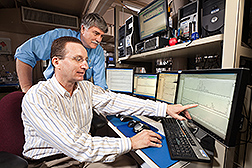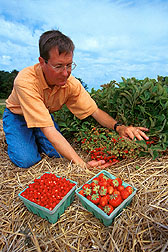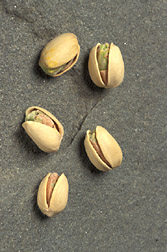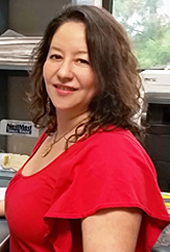This page has been archived and is being provided for reference purposes only. The page is no longer being updated, and therefore, links on the page may be invalid.
July 2018
FNRB Index | Search | Comments
Contents
More Definitive Food Profiles
Food Waste Resonates Beyond the Trash Bin
All Hail the Whole Grain!
Nuts for Calories!
Steven B. Heymsfield Presents 2018 ARS W.O. Atwater Memorial Lecture
ARS Scientist Finalist for Samuel J. Heyman Service to America Medal for Food Allergy Work

ARS chemists Craig Byrdwell (foreground) and James Harnly review data from a process they used to analyze the amount of vitamin D in milk, orange juice, and dietary supplements.
More Definitive Food Profiles
The most definitive nutrient profiles possible for many foods is a result of ARS-developed methods for analyzing food samples. The methods use seven different detectors—four mass spectrometers and one gas and two liquid chromatographs— to determine exactly what nutrients are in foods. Standard methods for determining a nutrient profile usually involve exposing food samples to ultraviolet (UV) light. But in many cases, UV readings don't give an accurate picture. Because the new methods reveal a nutrient’s molecular structure, the nutrient's bioavailability can be taken into account. Over the years, ARS scientists have corrected misperceptions about vitamin D levels in oysters (they don't have as much vitamin D as early studies indicated), identified differences in vitamin D from fish oils versus lanolin, and developed improved nutrient profiles of nutritional supplements, kale, various fruit drinks and vegetable juices and the seed oil in soybeans.
For details, contact: Craig Byrdwell, (301) 504-9357 ext. 230, Food Composition and Methods Development Laboratory, Beltsville, Maryland.

U.S. consumers wasted 150,000 tons of food daily from 2007-2014, with fruits and veggies topping the list.
Food Waste Resonates Beyond the Trash Bin
U.S. consumers waste nearly a pound of food per person per day, according to a study by ARS and university scientists. That food waste, in turn, is equivalent to about one-third the daily calories that each American consumes—about 327 million individuals. Fruits and vegetables were the most wasted food items, as determined by the team from their computer-aided analysis of eight years of available food survey data. The food-waste study was conducted to fill gaps left by prior research that sought to establish links between diet quality and environmental impacts. Other results include—U.S. consumers wasted almost a pound (422 grams) of food per person daily, and of 22 food groups studied, fruits, vegetables, and mixed fruit and vegetable dishes (39 percent of total) were wasted the most, followed by dairy (17 percent) and meat and mixed-meat dishes (14 percent).
For details, contact: Lisa Jahns, (701) 795-8331, Grand Forks (North Dakota) Human Nutrition Research Center, Grand Forks, North Dakota.
All Hail the Whole Grain!
A human nutrition study reaffirmed the health benefits of substituting whole-grain foods like whole-wheat bread, oatmeal, barley, rye, and brown or wild rice for refined-grain products like white bread in the diet. The study was the first to strictly control participants' diet, weight and type of whole-grain products they consumed. Among the results, participants in the whole-grain group lost approximately 100 more calories per day than refined-grain eaters—the equivalent of walking briskly for 30 minutes. The whole-grain diet also gave a moderate boost to beneficial gut bacteria that help stave off inflammation and pathogens.
For details, contact: Susan Roberts, (617) 556-3238, Energy Metabolism Laboratory, Jean Mayer USDA Human Nutrition Research Center on Aging, Boston, Massachusetts.

ARS scientists have shown that some tree nuts, such as pistachios, actually have fewer calories than previously thought by improving the method used for estimating calories.
Nuts for Calories!
Not all of nuts' calories are used by the human body; with some of them, the body gets a free pass, according to ARS studies. Calorie uptake from pistachios was 22.6 calories per gram, which is 5 percent less than the currently accepted 23.7 calories per gram. An ounce of pistachios has 161.9 calories, but only 153.8 calories are bioavailable. In walnuts, the team found an even greater discrepancy between what is reported on the label and the metabolizable energy (ME) value. They found that a 1-ounce serving of walnuts contained 146 calories, which is 39 calories—21 percent—less than what is on the label. Almonds were found to have 32 percent fewer calories of ME than what is on the label: 129 calories instead of 168-170 calories.
For details, contact: David Baer, (301) 504-8719, Food Components and Health Laboratory Beltsville, Maryland.
Steven B. Heymsfield Presents 2018 ARS W.O. Atwater Memorial Lecture
Steven B. Heymsfield presented the 2018 ARS W.O. Atwater Memorial Lecture, "From Measuring Rods and Calipers to Big Data: The Study of Human Body Composition Grows Up" at the Nutrition 2018 meeting in Boston. He pointed out that technological advances have afforded clinical nutrition investigators the opportunity to quantify body compartments with greater accuracy and depth than previously afforded. Paralleling other scientific fields, body composition measurement technologies are now generating vast amounts of digitally-measured data and are promising to provide greatly improved knowledge of the human shape. Heymsfield is internationally renowned for his work on obesity, body composition and energy physiology. He pioneered the use of computed tomography ("CAT scans"), magnetic resonance imaging (MRI) and dual-energy X-ray absorptiometry to study skeletal muscle, fat and visceral organs.
For details, contact: Steven B. Heymsfield, (225) 763-2541, Pennington Biomedical Research Center, Louisiana State University, Baton Rouge, Louisiana

Soheila J. Maleki
ARS Scientist Finalist for Samuel J. Heyman Service to America Medal for Food Allergy Work
ARS chemist Soheila Maleki was a finalist for a 2018 Samuel J. Heyman Service to America Medal in recognition of her 20-plus years of pioneering research that has improved the quality of life for millions of Americans who suffer from food allergies. The awards, also known as the “Sammies,” are given each year to Federal employees who have distinguished themselves by making our country safer, healthier and stronger. Maleki, with the Food Processing and Sensory Quality Research Unit in New Orleans, was recognized for her unique holistic research approach incorporating allergenicity as a consideration in peanut breeding and food processing. Her work has had a tremendous impact on advances in detection, diagnosis and treatment of food allergies. It changed how people are tested for peanut allergies and resolved a controversial issue by demonstrating that food processing changes the allergenic potential of foods.
For details, contact: Soheila Maleki, (504) 286-4590, Food Processing and Sensory Quality Research Unit, Southern Regional Research Center, New Orleans, Louisiana.



